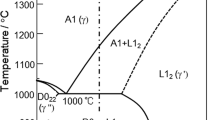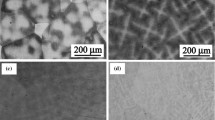Conclusions
The substitutional impurity element composition and content of nonmetallic inclusions in a W-Ni-Fe alloy are affected by their content in the charge starting components. These include salts and oxides or metallic powder components in a state controlled by the corresponding production conditions.
The nonmetallic inclusions in the alloy consist of multicomponent oxides distributed in the bulk as particles of different shape. Their content ranges from 0.1 to 0.4%.
Some impurity elements tend to form segregations and films at Ni-based solid solution grain surfaces. This is the binder of a W-Ni-Fe alloy.
During the alloy deformation process, nonmetallic binder inclusions, characterized by weak adhesive bonds with the matrix, play a role of pseudopores, absorbing slip bands.
Substitutional impurity elements tending to formation of segregations (Mo, S, etc.) lead to brittle intercrystallite failure.
Similar content being viewed by others
Literature cited
V. M. Finkel', Physical Bases of Failure Retardation [in Russian], Metallurgiya, Moscow (1977).
V. I. Trefilov, Yu. V. Mil'man, and S. A. Firstov, Physical Bases of Refractory Metal Strength [in Russian], Naukova Dumka, Kiev (1975).
V. M. Finkel' and I. A. Kutkin, “Cinematographic methods of studying crack growth in several materials,” Zavod. Lab.,29, No. 9, 1113–1118 (1963).
A. N. Zelikman and L. S. Nikitina, Tungsten [in Russian], Metallurgiya, Moscow (1978).
L. I. Klyachko, K. G. Koneva, K. S. Perel'muter, and A. M. Bakaev, “Impurity behavior during manufacture of tungsten compacts,” Tsvet. Met., No. 2, 77–83 (1965).
K. G. Burtseva and L. I. Klyachko, “Impurity behavior during fabrication of tungsten and molybdenum,” in: Metallurgy of Tungsten, Molybdenum, and Niobium [in Russian], Nauka, Moscow (1967), pp. 91–102.
Handbook of Chemical Reagents and High-Purity Chemical Materials [Russian translation], Khimiya, Moscow (1971).
B. A. Batyrev, E. V. Vasyukov, E. V. Kruglova, et al., “Nonmetallic inclusions in lithium and metalloceramic tungsten,” Izv. Akad. Nauk SSSR, Met., No. 6, 94–97 (1967).
R. Krok, “Inorganic composite materials,” in: Contemporary Composite Materials [Russian translation], Mir, Moscow (1970), pp. 13–40.
V. P. Minakov, L. M. Polyakov, and A. S. Tron', “Mechanical properties of thin copper films in composites,” Probl. Prochn., No. 10, 71–74 (1975).
G. I. Bel'chenko, S. I. Gubenko, and Yu. V. Yatsenko, “Effect of nonmetallic inclusions on the nucleation and growth of microfractures during deformation of 0810 steel,” Izv. Akad. Nauk SSSR, Met., No. 4, 161–167 (1978).
G. I. Bel'chenko and S. I. Gubenko, “Microinhomogeneous deformation of steel containing nometallic inclusions,” ibid., No. 4, 94–97 (1981).
F. Hull, A. Beardmore, and P. Valentine, “Crack propagation in single crystals of tungsten,” Philos. Mag.,12, No. 119, 1021–1041 (1965).
L. G. Bazhenova, A. D. Vasilev, R. V. Minakova, and V. I. Trefilov, “Nature of the low-temperature brittleness of a W-Ni-Fe alloy,” Poroshk. Metall. No. 1, 45–51 (1980).
V. N. Gridnev, Yu. N. Meshkov, S. P. Oshkaderov, and V. I. Trefilov, Physical Bases of the Electrothermal Reinforcement of Steel [in Russian], Naukova Dumka, Kiev (1973), p. 325.
Mak-Lin, Grain Boundaries in Metals [in Russian], Metallurgizdat, Moscow (1960).
E. Z. Glikman, R. É. Bruver, and I. Yu. Sarychev, “Determination of the impurity bonding energy with grain boundaries during formation of equilibrium segregations in alloys,” Fiz. Met. Metalloved.,30, No. 2, 391–396 (1970).
J. Vitart-Barbier, A. Larere, C. Roques-Carmes, and C. Saindrenan, “Effect of sulfur segregation on the intergranular properties of polycrystalline nickel,” Met. Etud. Sei. Rev. Met.,78, No. 7/8 (1981).
C. Loier and J. V. Boos, “Striation and faceting of grain boundaries in nickel due to sulfur and other elements,” Met. Trans.,A12, No. 1, 129–135 (1981).
Author information
Authors and Affiliations
Additional information
Deceased.
Translated from Poroshkovaya Metallurgiya, No. 11(251), pp. 72–78, November, 1983.
Rights and permissions
About this article
Cite this article
Minakova, R.V., Bazhenova, L.G., Verkhovodov, P.A. et al. Effect of impurity element substitution on the failure behavior of a W-Ni-Fe alloy. Powder Metall Met Ceram 22, 932–937 (1983). https://doi.org/10.1007/BF00805553
Received:
Issue Date:
DOI: https://doi.org/10.1007/BF00805553




